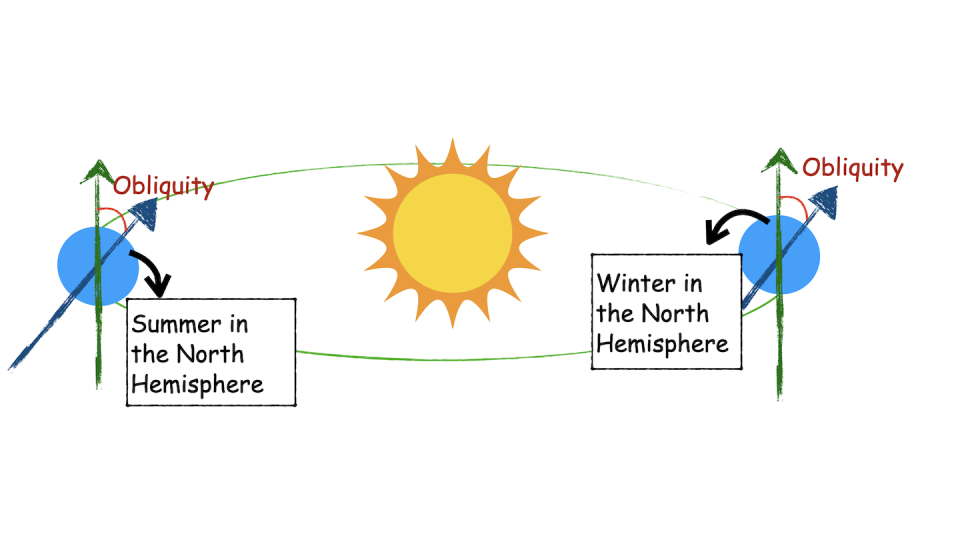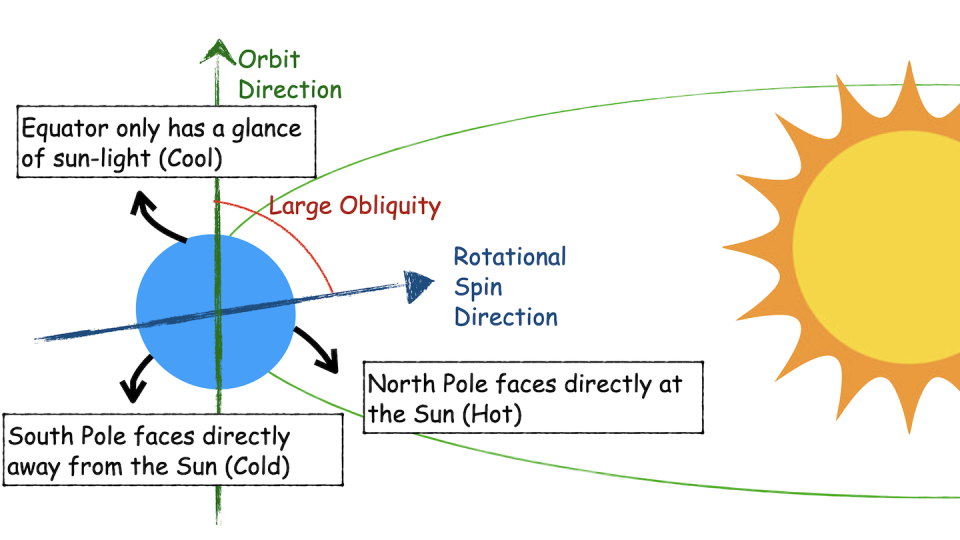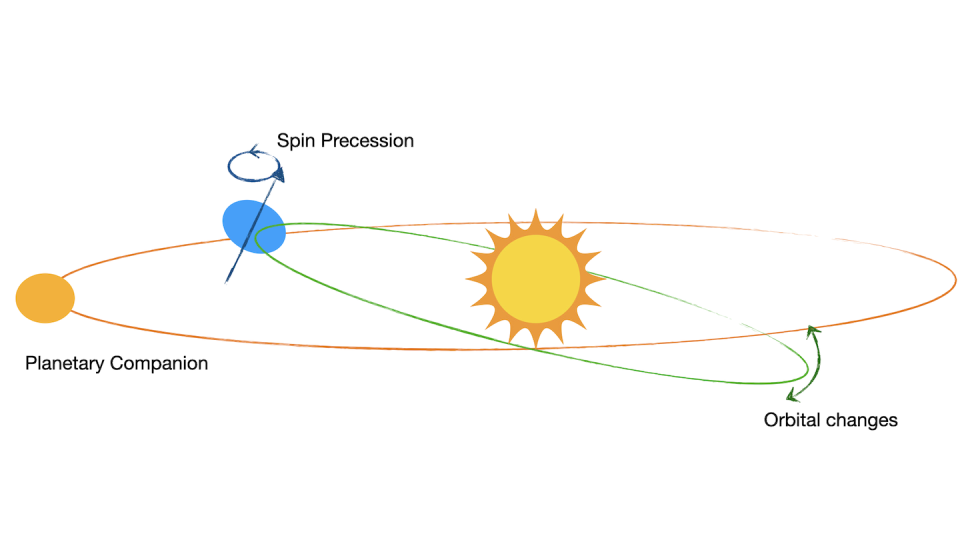Spring, summer, autumn and winter: the seasons on Earth change every few months, at about the same time every year. It’s easy to take this cycle for granted here on Earth, but not all planets have a regular change of seasons. So why does Earth have regular seasons when other planets don’t?
I am an astrophysicist who studies the movement of planets and the causes of seasons. Throughout my research, I discovered that Earth’s regular pattern of seasons is unique. The axis of rotation about which the Earth rotates, along the north and south poles, is not quite aligned with the vertical axis perpendicular to the Earth’s orbit around the Sun.
That slight tilt has big implications for everything from the seasons to glacier cycles. The magnitude of that tilt can even determine whether a planet is habitable for life.
Seasons on Earth
When a planet has a perfect alignment between the axis on which it orbits and the axis of rotation, the amount of sunlight it receives is fixed as it orbits the Sun, assuming its orbital shape is a circle. Since seasons come from variations in the amount of sunlight reaching the planet’s surface, a perfectly aligned planet would have no seasons. But the Earth is not perfectly aligned on its axis.
This small misalignment, called obliquity, is about 23 degrees from the Earth’s vertical. So, the Northern Hemisphere experiences more intense sunlight during the summer, when the Sun is positioned more directly over the Northern Hemisphere.
Then, as the Earth continues to orbit the Sun, the amount of sunlight the Northern Hemisphere receives gradually decreases as the Northern Hemisphere moves further away from the Sun. This causes winter.

Planets spinning on their axes and orbiting the Sun look like tops: They spin and wobble due to the Sun’s gravitational pull. As a top spins, you may notice that it doesn’t just stay perfectly upright and stationary. Instead, it may begin to lean or wobble slightly. This tilt is what astrophysicists call spin precession.
Because of these oscillations, the Earth’s obliquity is not perfectly fixed. These small variations in tilt can have big effects on Earth’s climate when combined with small changes in the shape of Earth’s orbit.
The wobble tilt and any natural variations in the shape of Earth’s orbit can change the amount and distribution of sunlight that reaches Earth. These small changes contribute to the planet’s largest temperature changes over thousands to hundreds of thousands of years. This, in turn, can lead to ice ages and periods of heat.
Translating obliquity into stations
So how do variations in obliquity affect a planet’s seasons? Low obliquity, meaning the axis of rotation is aligned with the planet’s orientation as it orbits the Sun, leads to stronger sunlight at the equator and little sunlight near the pole, as on Earth.
On the other hand, a high obliquity (meaning the planet’s axis of rotation points toward or away from the Sun) leads to extremely hot or cold poles. At the same time, the equator cools, since the Sun does not shine on it throughout the year. This causes drastic changes in the seasons at high latitudes and low temperatures at the equator.


When a planet has an obliquity of more than 54 degrees, that planet’s equator freezes and the pole warms. This is called inverted zonation and is the opposite of what Earth has.
Basically, if an obliquity has large and unpredictable variations, the seasonal variations on the planet become wild and difficult to predict. A large and dramatic obliquity change can turn the entire planet into a snowball, where everything will be covered in ice.
Spin Orbit Resonances
Most planets are not the only planets in their solar systems. Their planetary siblings can disturb each other’s orbit, which can cause variations in the shape of their orbits and their orbital inclination.
So, orbiting planets look like tops spinning on the roof of a car moving down the road, where the car represents the orbital plane. When the speed (or frequency, as scientists call it) at which the tops precess or spin matches the frequency at which the car goes up and down, something called spin-orbit resonance occurs.


Spin orbit resonances can cause these obliquity variations, which is when a planet wobbles on its axis. Think about pushing a child on a swing. When you press at just the right moment (or at the resonant frequency), they will oscillate higher and higher.
Mars wobbles more on its axis than Earth, even though they are both tilted about the same amount, and that actually has to do with the Moon orbiting Earth. Earth and Mars have a similar spin precession frequency, which coincides with orbital wobble, the ingredients of a spin orbit resonance.
But the Earth has a huge Moon, which pulls on the Earth’s axis of rotation and drives it to move faster. This slightly faster precession prevents it from experiencing resonances in the spin orbit. So the Moon stabilizes the Earth’s obliquity and the Earth doesn’t wobble on its axis as much as Mars does.
Exoplanet seasons
Thousands of exoplanets, or planets outside our solar system, have been discovered in recent decades. My research group wanted to understand how habitable these planets are and if these exoplanets also have wild obliquities or if they have moons to stabilize them like Earth.
To investigate this, my group has conducted the first investigation into variations in the spin axis of exoplanets.
We investigate Kepler-186f, which is the first Earth-sized planet discovered in a habitable zone. The habitable zone is an area around a star where liquid water can exist on the planet’s surface and life can emerge and thrive.
Unlike Earth, Kepler-186f is far from the other planets in its solar system. As a result, these other planets have only a weak effect on its orbit and motion. So Kepler-186f generally has a fixed obliquity, similar to that of Earth. Even without a large moon, it doesn’t have unpredictable or highly changeable seasons like Mars.
Looking ahead, more exoplanet research will help scientists understand what the seasons are like across the vast diversity of planets in the universe.
This article is republished from The Conversation, an independent, nonprofit news organization bringing you data and analysis to help you understand our complex world.
It was written by: Gongjie Li, Georgia Institute of Technology.
Read more:
Gongjie Li receives funding from NASA.